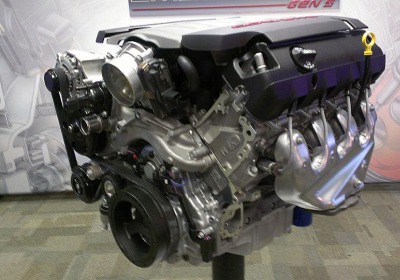UPDATED: 2014 Chevrolet Corvette LT1 V8 to make 460 hp, 465 lb-ft
Wed, 24 Oct 2012
UPDATED 5/28/2013: Chevrolet has officially rated the 2014 Corvette Stingray LT1 V8 at 460 hp at 6,000 rpm and 465 lb-ft of torque at 4,000 rpm. Chevy claims up to 316 lb-ft of torque is available starting at 1,000 rpm. Check out complete LT1 details below, and look for an upcoming breakdown of the latest LT1.
The 2014 Chevy Corvette will be powered by an all-new 6.2-liter V8 that combines direct fuel injection, continuously variable camshaft timing and cylinder deactivation to make the sports car both powerful and fuel efficient.
General Motors unveiled the new V8 on Wednesday, and said it will produce at least 450 horsepower and 450 lb-ft of torque. It will power the new Corvette, set to be unveiled in January at the Detroit auto show, from 0 to 60 mph in less than 4 seconds.
The engine is also expected to help the new Corvette get better fuel economy. The current Corvette is rated at 26 mpg on the highway.
The aluminum engine, designated LT1, is the first version of the fifth generation of GM's small block V8. GM has plans to use other versions of the fifth-generation small block in other products, including the redesigned 2014 full-size pickups and SUVs.
Higher-performance versions of the new engine are also likely for the new Corvette. GM and Corvette officials would not discuss future plans.
The base engine for the 2013 Corvette, known as the LS3, also displaces 6.2 liters and is rated at 430 hp and 424 lb-ft of torque. The current Corvette engine does not use direct injection, variable camshaft or cylinder deactivation.
“When you talk to Corvette customers, the most important part of the car for them is the engine,” said Tadge Juechter, the Corvette's executive chief engineer.
He added that Corvette fans show little interest in smaller engines. “They want their Corvette to have a V8,” he said.
Trio of new technologies
The LT1 engine uses three key technologies:
1. Direct fuel injection, which sprays fuel directly into the cylinder to mix with incoming air. The technology, which uses a high-pressure fuel system, lets the engine use less fuel for each cylinder and reduces emissions. GM believes the LT1 is the first time direct injection has been used with an overhead valve engine.
2. Cylinder deactivation, which shuts down four of the engine's eight cylinders when the Corvette engine is under light load, such as cruising on the freeway. The technology turns the Corvette's V8 into a four-cylinder, saving fuel.
3. Continuously variable camshaft timing, which enables the engine to open and close its intake and exhaust valves at the best time for power or fuel economy, depending on the demand from the driver.
GM has been working on the new engine for five years. The first two years of work focused on the combustion chamber and making the air flow and fuel burn as efficient as possible, said Jordan Lee, chief engineer for the engine program.
Key changes to the engine include moving the spark plug to a central location in the combustion chamber and pistons that have a complex design on the surface to contain the air-fuel mixture.
GM engineers plan to present a paper at the 2013 SAE convention to detail and explain the improvements to fuel economy and emissions gained with the engine design.
Other engine details:
-- The fuel flow will shut off at 6,600 rpm.
-- The engine has an 11.5:1 compression ratio. That higher than the current engine's 10.7:1 compression ratio. Despite the higher ratio, the new Corvette can run on regular unleaded fuel although premium fuel will be recommended.
-- The LT1 engine has 50 lb-ft more torque at low rpm than the current engine, which delivers more pulling power. The engine's low-end torque is comparable to the LS7 V8 used on the current high-performance Corvette Z06.
-- The LT1 will be available with wet sump and dry sump oiling systems. A dry sump system, typically used for high-performance and race engines, does away with the conventional oil pan and uses an oil reservoir mounted in the car.
-- The added technology makes the LT1 engine heavier than the current LS3 V8, although GM officials would not say by how much. The addition of new technologies made the engine heavier but it was worth the tradeoff for improved fuel economy and performance, Juechter said.
-- GM will build the LT1 engine at its Tonawanda plant near Buffalo, N.Y. The plant has plenty more capacity to build small block V8s than the Corvette program will need.
-- This is the third time GM has used the LT1 designation for a Corvette engine. The LT-1 V8was used in the Corvette in 1970-1972; and an LT1 version of the second-generation small block V8 was used in the Corvette from 1992-96.
By Dale Jewett

